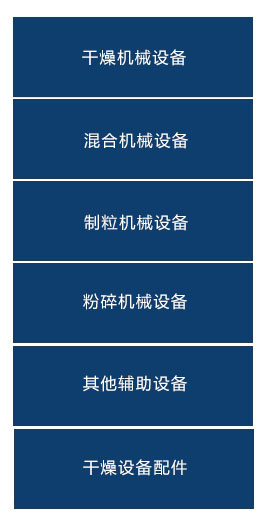
|
|
閃蒸干燥器: 對于廣泛的精細和粗糙的材料,包括纖維,魚粉,粘土金屬粉末,顏料,聚合物,谷物和淀粉的高效干燥。 實驗室流化床干燥設(shè)備 - 特點與優(yōu)勢 一旦通過流動的產(chǎn)品,保護溫度敏感的材料。 材料均勻地分散在熱空氣流,統(tǒng)一的產(chǎn)品治療。 靜態(tài)分類較細的干燥物料直接發(fā)送到產(chǎn)品的出口,并保持較大的顆粒,在空氣流中,直至干燥。 受控制的停留時間是可調(diào)的,以提供足夠的時間,進行干燥或其他化學(xué)反應(yīng)。 分散呼吸機打破了大的聚集,而不會產(chǎn)生罰款。 只有一個運動部件,的氣流降低維護成本。 垂直結(jié)構(gòu)^大限度地減少占地空間。 植物經(jīng)過驗證的設(shè)計保證^小的操作員注意。 高效節(jié)能干燥系統(tǒng)完整的定制設(shè)計。Flash Dryers: For the efficient drying of a wide range of fine and coarse materials including Fibers, Fish Meals, Clays Metallic Powders, Pigments, Polymers, Grains and Starches. Laboratory fluid bed drying equipment - Features & Advantages Once through flow of product, protects temperature sensitive materials. Material evenly dispersed in hot air streams, uniform product treatment. Static classifier sends finer dry material directly to the product outlet, and keeps larger particles in the air stream until dry. Controlled residence time is adjustable to provide sufficient time for drying or for other chemical reactions. Disperser ventilator breaks up large agglomerates without producing fines. One moving part in airstream minimizes maintenance costs. Vertical construction minimizes floor space. Plant proven design ensures minimal operator attention required. Energy efficient complete Custom Engineered Drying Systems.實驗室流化床干燥設(shè)備 - 工藝說明 材料被引入的熱空氣流中的文丘里管或管喂料器。熱空氣和產(chǎn)品被輸送到分散機/呼吸機,打破了大的附聚物,并進一步完成之間的熱空氣的混合過程和產(chǎn)品。熱空氣和產(chǎn)品,然后輸入的垂直列和靜態(tài)分類器,其中在干燥的大部分發(fā)生。較小的顆粒立即擦干,并報告到干燥器的出口被輸送到產(chǎn)品的收集系統(tǒng)。粗糙,仍然是濕的產(chǎn)品被保持在干燥器列,直到它變干,在這一點,它被輸送到干燥器插座。大的附聚物傾向于相互碰撞,從而暴露到熱空氣的濕材料。通過蒸汽或熱油或直燃式燃氣取暖可以是間接的。燃燒器可設(shè)計為氣態(tài)或液態(tài)燃料與設(shè)置來滿足IRI,F(xiàn)M或當(dāng)?shù)氐臉藴士丶T撓到y(tǒng)的控制設(shè)置為運行在手動或自動模式下,PLC用于控制啟動和關(guān)閉排序,如果需要的。統(tǒng)計流體干燥設(shè)備的過程 干燥過程:連續(xù)的,從熱氣體直接接觸換熱產(chǎn)品干燥介質(zhì):空氣,氮氣,過熱蒸汽進樣口溫度范圍:250到1800出風(fēng)口溫度范圍:180至240Laboratory fluid bed drying equipment - Process Description Material is introduced into the hot air stream in a venturi or tube feeder. The hot air and product are conveyed into the Disperser/Ventilator which breaks up large agglomerates and further completes the mixing process between hot air and product.The hot air and product then enter the vertical column and static classifier where the bulk of the drying takes place. Smaller particles dry immediately, and report to the outlet of the dryer to be conveyed onto the product collection system. The coarser, still wet product is retained in the dryer column until it dries, at which point it is conveyed to the dryer outlet. Large agglomerates tend to collide with each other, thus exposing the wet material to the hot air.Gas heating can be indirect via steam or hot oil or direct fired. Combustors can be designed for gaseous or liquid fuels with controls set up to meet IRI, FM or local standards. The system controls are set up to run in an either manual or automatic mode, with PLC’s used to control the start up and shutdown sequencing if desired.Statistics for our fluid drying equipment process Drying Process:Continuous, direct contact heat transfer from hot gas to productDrying Media: Air, Nitrogen, superheated steamInlet temperature range: 250 to 1,800Outlet temperature range: 180 to 240特點與優(yōu)勢 •干和去附聚物在一個單一的步驟 •粒子粒子碰撞達到優(yōu)良的產(chǎn)品,而無需移動部件 •極短的停留時間,對溫度敏感的產(chǎn)品 •占地面積小,建筑空間的要求^小化 •噴射研磨原則保持在潮濕的飼料顆粒分布存在 •靜態(tài)分類^大限度地減少產(chǎn)品topsize •高效節(jié)能完整的定制設(shè)計的干燥系統(tǒng) 工藝說明 加熱的低壓空氣注入通過一系列的噴嘴進入干燥機的干燥室下部 的切線上,建立一個高速循環(huán)流動的氣體。也成角度的噴嘴,以便排氣 每個噴嘴的影響以前的噴嘴的排氣。高速粒子之間的碰撞 作為結(jié)果的碰撞氣流以及自然擴展所產(chǎn)生的渦流發(fā)生 氣體的噴射而。 材料傳送到該系統(tǒng)為一個蛋糕,粉末,或backmized的淤漿,并輸入通過旋轉(zhuǎn)干燥器 閥,文氏管,或送紙器。水泥漿也可以被霧化直接在干燥器中時所需的。原料 進入循環(huán)熱空氣的上游側(cè)的第一噴嘴,與離心力所產(chǎn)生的空氣 濃縮的材料在噴嘴上方的區(qū)域。粒子的粒子碰撞立即開始,松團作用的材料,可以形成硬團聚之前。創(chuàng)建一個巨大的表面積 允許蒸發(fā)迅速發(fā)生,從而按壓在一個非常短的時間內(nèi)的空氣溫度。 離心力所產(chǎn)生的干燥機內(nèi)的再循環(huán)氣體,迫使較大的顆粒的 周壁。更細的材料的干燥器中的分類器的出口的內(nèi)半徑移向 所在的位置。優(yōu)良的產(chǎn)品出口隨著排氣蒸汽干燥器。更大的顆粒或附聚物 再循環(huán)到噴嘴面積干燥器中進一步附聚和干燥。 干燥過程:連續(xù)直接接觸 干燥介質(zhì):空氣,氮氣, 過熱蒸汽 進樣口溫度范圍:180至1800 F 出口溫度范圍:130?1600快 材料停留時間:0.5?2秒 銑削操作:氣流粉碎原理, 低壓氣體噴流 縮寫的應(yīng)用程序列表: 藻酸鹽 無定形二氧化硅 啤酒酵母 碳酸鈣 硫酸銅 食品級纖維 除草劑 高嶺土 金屬氫氧化物 金屬硬脂酸鹽 金屬氧化物 云母 有機顏料 藥湖 聚合物 淀粉 滑石 乙酸異丁酯FEATURES & ADVANTAGES • Dry and de-agglomerate in a single step • Particle-to particle collisions achieve fine products without moving parts • Extremely short residence times for temperature-sensitive products • Small footprint minimizes building space requirements • Jet milling principles preserve particle distribution present in wet feed • Static classifier minimizes product topsize • Energy efficient complete Custom Engineered Drying Systems PROCESS DESCRIPTION Heated low pressure air is injected into the lower drying chamber via a series of nozzles that enter the dryer on the tangent, setting up a high velocity recirculating flow of gas. The nozzles are also angled so the exhaust of each nozzle impacts upon the exhaust of the previous nozzle. High velocity collisions between particles occur as a result of the colliding gas streams as well as the eddy currents generated by the natural expansion of the jet of gas. Materials are delivered to the system as a cake, powder, or backmized slurry and enter the dryer via a rotary valve, venturi, or feeder. Slurries can also be atomizes directly in the dryer when desired. The feed material enters the recirculating hot air upstream of the first nozzle, with the centrifugal forces generated by the air concentrating the material in the area above the nozzles. Particle-to-particle collisions begin immediately, deagglomerating the material before hard agglomerates can form. A tremendous amount of surface area is created allowing evaporation to occur quickly, thereby depressing air temperature in a very short period of time. Centrifugal forces are generated by the recirculating gases within the dryer, forcing the larger particles to the peripheral walls. Finer material is displaced towards the inside radius of the dryer where the classifer outlet is located. Fine product exits the dryer along with the exhaust gas vapor. Larger particles or agglomerates are recycled to the nozzle area dryer for further de-agglomeration and drying. Drying Process: Continuous direct contact Drying Media: Air, nitrogen, superheated steam Inlet Temperature Range: 180 to 1800 F Outlet Temperature Range: 130 to 1600 F Material Residence Time: 0.5 to 2 seconds Milling Action: Jet milling principles, using low pressure jets of gas Abbreviated Application List: Alginates Amorphous Silica Brewer's Yeast Calcium Carbonate Copper Sulfate Food Grade Fibers Herbicides Kaolin Metallic Hydroxides Metallic Stearates Metallic Oxides Mica Organic Pigments Pharmaceutical Lakes Polymers Starches Talc Titanium Dioxide.正文結(jié)束!干燥——國家高新技術(shù)企業(yè),多項干燥設(shè)備專利單位,行業(yè)標準主起草單位;尤其在閃蒸干燥機,噴霧干燥機,真空干燥機,帶式干燥機, 振動流化床,沸騰干燥機的研發(fā)制造方面有較強的優(yōu)勢,歡迎與我們聯(lián)系!首要,第一個要素便是我們在出產(chǎn)農(nóng)藥干燥機時運用了過量的膠水,膠水的過量會致使在瓦楞上粘接許多膠水,在紙板單調(diào)過程中,面紙與瓦楞的粘合出首要被許多吸水并再次單調(diào)往后瓦楞紙板就簡略漏楞。處理這個最好的辦法便是嚴峻掌控膠水質(zhì)量與膠水的施膠量,只需這么才會有用減少或許降低漏楞現(xiàn)象。 其次,我們在操作農(nóng)藥干親愛的QQ用戶:
當(dāng)您看到這封信的時候,我們剛剛作出了一個非常艱難的決定。在360公司停止對QQ進行外掛侵犯和惡意詆毀之前,我們決定將在裝有360軟件的電腦上停止運行QQ軟件。我們深知這樣會給您造成一定的不便,我們誠懇地向您致歉。同時也把作出這一決定的原因?qū)懺谙旅妫瓮玫侥睦斫夂椭С帧N勰嗪娓蓹C顧名思義即用于泥土干化設(shè)備。污泥烘干機可一次性將90%含水量的物料烘干至成品。污泥烘干機適用于城市污泥干化。污泥的干化處理,使污泥農(nóng)用、作為燃料使用、焚燒乃至為減少填埋場地等處理方法成為可能。污泥烘干機針對類似污泥這種具有高水分、高粘性、高持水性和低熱值等特點的物料,專門研發(fā)出來的專用干燥干燥機的產(chǎn)品和技術(shù)簡介:
(一)主要干燥機:
1、壓力式噴霧干燥機:由液態(tài)物料獲得粉狀產(chǎn)品的系列壓力式噴霧干燥機、2、系列旋轉(zhuǎn)式噴霧干燥機:由液態(tài)物料獲得大顆粒產(chǎn)品的系列流化床噴霧造粒干燥機;由濾餅或膏糊狀物料獲得粉狀產(chǎn)品的系列大型雙農(nóng)藥干燥機的控制系統(tǒng)包括加熱系統(tǒng)、冷卻系統(tǒng)及工藝參數(shù)測量系統(tǒng),主要由電器、儀表和執(zhí)行機構(gòu)(即控制屏和操作臺)組成。大型雙農(nóng)藥干燥機其主要作用是:控制和調(diào)節(jié)主輔機的拖動電機,輸出符合工藝要求的轉(zhuǎn)速和功率,并能使主輔機協(xié)調(diào)工作;檢測和調(diào)節(jié)擠塑機中塑料的溫度、壓力、流量;實現(xiàn)對整個機組的控制或自動控 |
· 相關(guān)行業(yè)產(chǎn)品:
· 最新行業(yè)資訊:
· 鄭重聲明:
1、本站文章均從網(wǎng)絡(luò)搜集轉(zhuǎn)載,意在傳播更多信息,并不代表本站觀點,本站也無法對其真實性進行考證、負責(zé)。
2、如轉(zhuǎn)載內(nèi)容牽涉到作品版權(quán)問題,并非出于本站故意!在接到相關(guān)權(quán)利人通知后我們會在第一時間加以更正。
3、轉(zhuǎn)載本站文章請注明出自http://www.yjxyings.cn/,謝謝合作!
|


